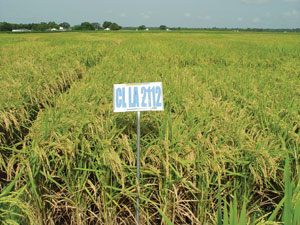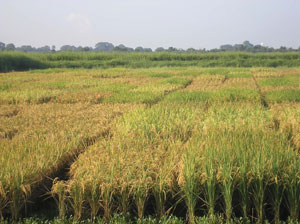
Features
Agronomy
Other Crops
Growing rice in southern Ontario
Some types of clay are best suited to the crop.
February 20, 2009 By Blair Andrews
The emergence of the local food trend is sparking interest in crops that are not normally grown in eastern Canada. Consumers are seeking local food products for a variety of reasons including food safety, supporting their local farmers and reducing their carbon footprint. Rice is one of the more popular food crops that must travel thousands of kilometres to reach Canada’s major markets. Meanwhile, more rice than ever before is being consumed in Canadian diets. According to Statistics Canada, rice available for consumption set a new record in 2007, reaching 5.2 kg per person.
 |
| Research in the late 1960s indicated rice could be grown to maturity in southwestern Ontario, and it could grow again, insists Dr. Caldwell. Photos courtesy of Dr. A. George Caldwell. |
The combination of local food interest and the increased consumption begs an obvious question: Could rice be grown in southern Ontario? It should be noted that the rice crop being cited here is paddy rice or rough rice, which is grown in rice paddies. Wild rice, which matures in other regions in Ontario, is a
different species.
The concept of growing rice in Ontario has been examined well before this era of local food enlightenment. Dr. A. George Caldwell, a retired professor of soil chemistry from Louisiana State University, is a longtime proponent of growing rice in the southern part of the province. He believes the flat, clay soils of Lambton County, in particular, are ideally suited to grow the crop. Caldwell, who grew up in Watford, Ontario, mapped the soils in Lambton County in 1947-48. The key, he says, is that a good part of central Lambton sits on Jeddo clay. “Brookston clay is the major, flat clay soil in Essex, Chatham-Kent and the southern edge of Lambton County. It’s tile-drained and grows great corn, soybeans and wheat,” says Caldwell. “Jeddo clay has more shale. This makes the soil even more clayey than Brookston and it is slightly more acidic. On Jeddo in Lambton, they’re growing sparse grass. You’ll find many thousands of acres of Jeddo with very low production.”
In addition to the appropriate soil type, the production of rice requires water. Caldwell says that is something else that Lambton can readily provide. “In Lambton, there’s been a big drainage program to get excess rain water off the land. This actually represents an opportunity to maybe get the water back in. You could use the drains to bring water from the St. Clair River back into Lambton.”
Rice has a history in Ontario
Caldwell adds that rice has been grown before in the province. Field trials conducted by the Ontario Research Foundation in 1967 showed that early season varieties of rice will mature in southwestern Ontario. The experimental rice was harvested on 2.5 acres in the Grand River Valley near Dunnville. Caldwell says the yield was more than 5000 pounds of rough rice per acre. Rough rice is the term that refers to the rice as it comes off the field before processing, where its protective hull is removed. “Rough rice in Houston is 10.5 cents per pound,” notes Caldwell, citing the price in late 2008. “So you’re talking about maybe a $500 to $600 per acre harvest.”
 |
| As always, price dictates whether rice might make it as a commodity in Ontario, and go beyond test plots like these. |
Furthermore, Caldwell says important advancements in rice breeding have occurred since the 1967 research. He suggests that some short-season rice varieties developed for Louisiana would be ideal for Ontario’s climate. Referred to as “90-day” rice, these varieties are planted in March or April in Louisiana for harvest at the end of July. As for Ontario, Caldwell says rice could be planted between the 15th and 24th of May and would likely be combined around the first of September, depending on maturity.
In a more a recent experiment, paddy rice was grown for two years near Holiday Beach in Essex County in the late 1990s. Led by Ducks Unlimited Canada, conservation was a key focus of the project as the flooded fields would produce excellent feeding grounds for waterfowl. Dr. Soon Park, a crop breeder from the Agriculture and Agri-Food Canada research station at Harrow, Ontario, was one of several people who participated in the study. Now retired, Park, is well known for his work with dry bean crops. But he started his career in 1963 as a rice breeder at a research station in Suwon, Korea, with training stints at an international rice research centre in the Philippines.
The Essex County project used a few varieties of short-grain rice from California, Japan and Korea. Park says the experimental area yielded a fair amount of rice. “When we harvested, yield was quite good. Actually, I was surprised the second year,” recalls Park, who estimated the yield at five tonnes/ha (about 4460 lbs/ac) with hulls removed.
He adds that a small, experimental combine for edible beans, soybeans and wheat was used to combine the rice.
From an agronomic standpoint, Park agrees with Caldwell’s assertion the rice can be grown in southern Ontario. On the question of it being economically feasible, Park is much less certain. He explains that the yields from the Essex County project were about 30 to 50 percent smaller than those in California. “I’m not sure if our production record will be competitive with California rice. That’s one of the reasons why I have doubts,” he says.
The rice fields also produced broadleaf and grassy weeds, prompting Park to say that more weed science research would be required in future projects.
Justifying the costs
Echoing Park’s comments, Peter Johnson, cereal specialist with the Ontario Ministry of Agriculture, Food and Rural Affairs, says rough rice could be grown in the province but there are several challenges, including a limited amount of potential acreage and high infrastructure costs. “Is it a valuable enough commodity to justify the expenses? Because in most places of the world where they grow rice, the infrastructure already exists in a crop that is really a commodity,” explains Johnson.
Drawing a comparison with horticulture crops, Johnson says the rice scenario would be different than investing in something like Bok Choy production. “The input costs are high but the potential return is huge if you find the market and if you have a good quality crop. I’m not saying horticulture production is easy. It’s still a risk. But at least when you hit it, you can hit it big.”
Conversely, a commodity, says Johnson, does not sell much above the cost of production. As for research, he is not aware of any new studies related to growing rice as an alternative crop. He says many efforts are related to using crops for different applications as well as supplying a bigger portion of our energy needs.
Johnson and Park do not completely rule out the possibility of growing rice in the future. Acknowledging the local food interest, Johnson says there is definitely a transportation advantage to supplying the local market. Park says higher food prices could change the outlook as well. According to the Consumer Price Index, the price of rice increased 2.5 percent from 2006 to 2007. Park has noticed an even higher increase in recent months. “The rice price at the supermarket almost doubled, from $7.99 per eight kilogram bag in 2007 to a cost of $13.50. And sometimes it’s not available. So if the price is still like that it may be a different story for growing rice in Ontario.”
He recommends that an economic analysis would be needed to justify growing rough rice in the province at a commercial scale. More than 40 years later, this recommendation strongly reflects the conclusions of the 1967 research. “It appears that there are commercial possibilities for rice growing in southwestern Ontario. Paddy rice is not an easy crop to grow and whether it develops will depend on cost of product and sale prices that cannot be specified at present,” wrote L.J. Chapman, director of the Department of Physiography of the Ontario Research Foundation.